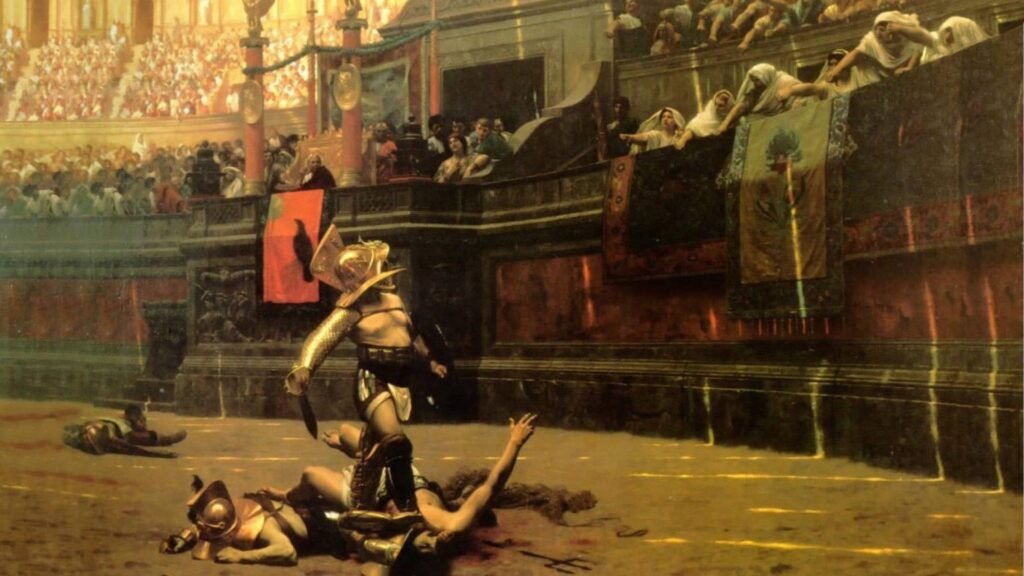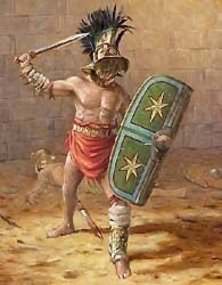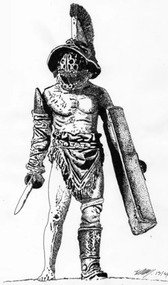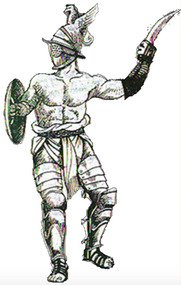Gladiators were armed combatants who engaged in combat with other gladiators, condemned criminals, and wild animals to entertain the Roman public. Gladiators were widely recognized, and their value as entertainers was celebrated in high and low art forms throughout the Roman world. In this article, we will explore the different types of gladiators in ancient Rome, shedding light on their names and distinctive features.

How did Gladiator fights begin?
The first gladiators battled to death during the funeral of Junius Brutus Pera, an esteemed aristocrat, in 264 B.C. The event was organized by his family to honor his passing and provide a bloody sacrifice for the gods.
The Roman aristocracy found this gruesome spectacle fitting for the funeral and it soon became popular. Julius Caesar further popularized the gladiatorial games by organizing a show featuring 320 pairs of gladiators to honor his deceased father and daughter.
By the end of the first century B.C., the Roman leadership began organizing public games and built the Colosseum, turning impromptu battles into serious business.
Different types of gladiators
There were more than 30 different types of gladiators divided into different classes depending on the types of weapons, shields, and armor used.
The pairing of adversaries was significant as the Romans valued “fair play” in gladiatorial combats. Therefore, the organizers would match Gladiators based on their preferred weapons.
Interestingly, some of the most renowned gladiators did not use swords but rather employed a combination of a spear and net.
10: Samnite

Weapons: Samnite sword, shield
The Samnites were one of the earliest types of gladiators in the gladiatorial games. They were typically warriors from Samnium, the region of Southern-central Italy that had been defeated by Rome and forced to fight for entertainment.
However, the Samnite gladiators disappeared after Samnium was conquered and incorporated into the Roman Empire under the reign of Emperor Augustus.
The Samnite gladiators wore unique attire consisting of a helmet with a visor grating, a crest, and a high plume. They used a Samnite sword that resembled the Roman gladius, a short sword utilized by Roman soldiers, and carried a full-length shield that they tapered at the bottom and flared at the top.
9: Velitus
Weapons: Spear
Velitus are presumed to have fought in groups against one or more combatants. They were armed with a spear and a small shield and were not seen as good prospects.
8: Dimachaerus
Weapons: Dual swords
Dimachaeri gladiators were skilled in close combat, fighting with two swords simultaneously to deliver a flurry of slicing strikes on their enemies.
Although this style of fighting required a high degree of expertise, it was not as renowned as other gladiator types in the Colosseum. The Romans considered it to be devious and unscrupulous.
Dimachaeri fighters waited for the perfect moment to strike, relentlessly attacking their opponents’ bodies over and over. Despite being agile and not weighed down by heavy armor, they often paired against opponents who were more heavily armored.
7: Eques
Weapons: Spear, sword, round shield
Equites gladiators were named after an aristocratic equestrian class of the same name, carrying a spear, sword, and round, calvary shield.
Middle-to-higher class of citizen-aristocracy was forbidden from fighting in the arena. Therefore, these performers imitated mounted Roman knights in their performances.
Once the bout started, a horse-mounted eques gladiator would enter the ring and begin battling with a lance. If anyone fell off his horse during the fight, the battle would proceed on foot among the combatants wielding swords for close-range combat.
6: Retiarius

Weapons: Trident, weighted net
Retiarius was a type of Roman gladiator renowned for the use of weighted nets to entrap their opponents. They were extremely famous and highly regarded in the Colosseum, but their connection with femininity and homosexuality led to them experiencing a lower social status.
They were very lightly armored, with some wearing only a loincloth, making them very agile. Retiarii went against much more heavily armored opponents with a long trident and short dagger. However, they did have a heavy net to entrap their opponents.
5: Laquerius
Weapons: Noose, trident
Laquerius was a type of gladiator, similar to Retiarius, who used a noose instead of a heavy net and a sword instead of a trident. They were likely based on a barbarian tribe known as Sagartians and used the noose to snare their opponents followed by a strike from the blade.
4: Secutor

Weapons: Gladius, dagger
The Secutor was a type of gladiator in Ancient Rome that was known to chase their opponent with a sword. Originating around 50 CE, a Secutor gladiator carried a gladius or a dagger and was protected by heavy armor.
They were specifically trained to fight against the Retiarius, a type of gladiator that used a heavy net to ensnare their opponents.
A Secutor’s smooth, rounded helmet is the most noticeable aspect of their appearance. It was designed to prevent entanglement in nets with only two small eyeholes for visibility. Carrying their armor in a match could cause fatigue, and the helmet’s shape hindered their ability to breathe deeply.
3: Hoplomachus
Weapons: Sword, spear
Hopolomachus was a type of gladiator class in the style of a Greek hoplite. They were heavily armored and fought with a spear and short sword. Additionally, they donned a visored helmet featuring a massive crest ridge.
They were pitted against Murmillones gladiators who were symbolic of Roman soldiers to reenact the Roman-Greek wars.
2: Murmillo

Weapons: sword, square shield
The Murmillo was a type of gladiator during the Imperial Age of the Roman Empire to replace the Gallus type. They were recognized by their distinctive copper/bronze helmet, which had a wide neck guard and a visor grating made of copper.
They used a gladius to attack and had a large square shield capable of covering half of their body for protection. It was common for the Murmillo to fight against either Tharex or Retiarius.
1: Thraex

Weapons: Short sword, triangular shield
The Thraex is probably the most well-known of all gladiator types. Immortalized through the story of Spartacus, the Thracian slave gladiator who gathered an army of 70,000 slaves and led an uprising against the Roman Empire, winning several battles against his captors.
They were usually armed in the Thracian style with a sica, a small and curved sword used to attack the unarmoured back of their opponents. The Thraex gladiators were popular among women but usually died gruesomely due to lack of training.
